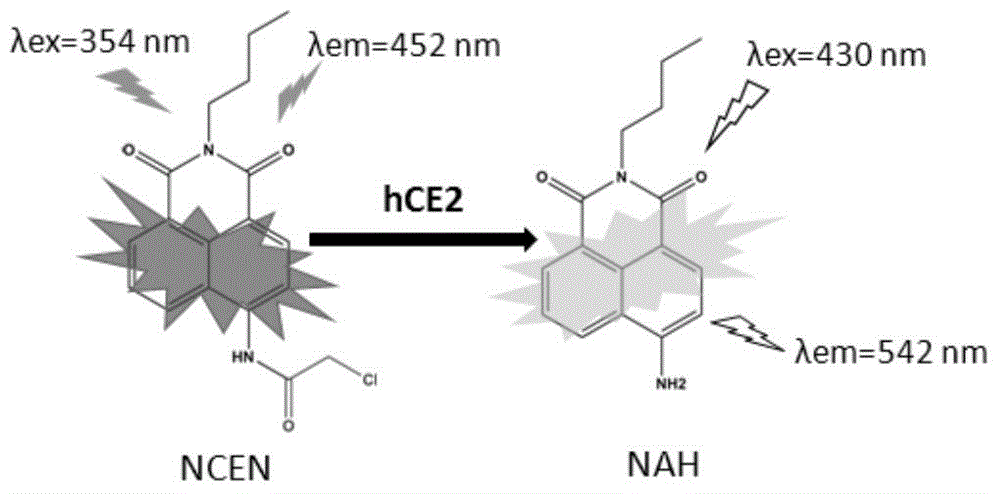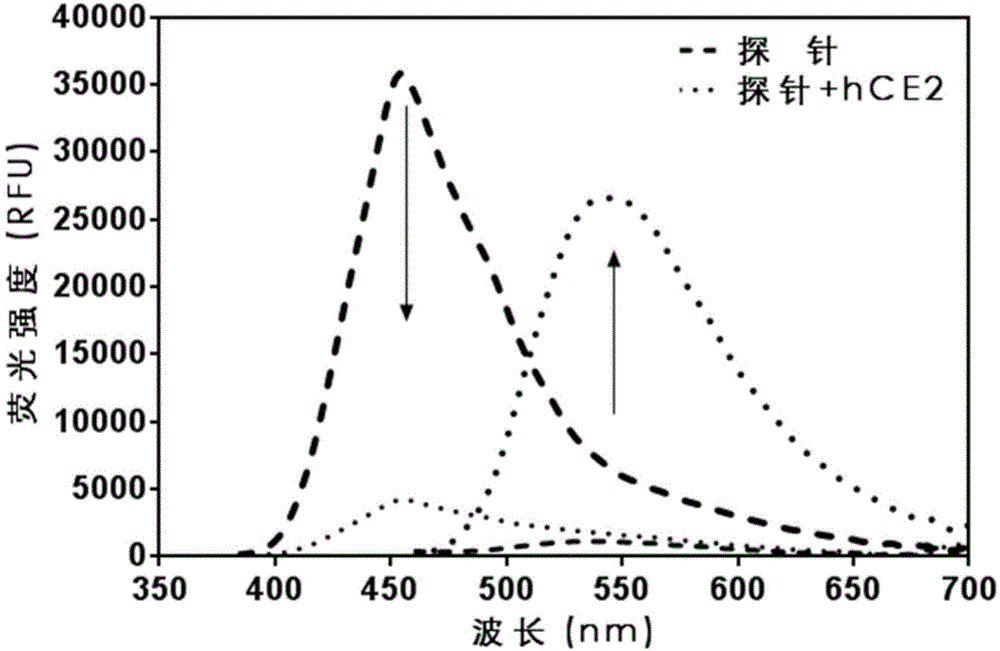Human carboxylesterases 2 detection kit and application method and application thereof
A human carboxylate and kit technology, applied in the field of medicine, can solve the problems of expensive antibodies, complicated and time-consuming processes, and achieve the effect of simple and easy synthesis process
- Summary
- Abstract
- Description
- Claims
- Application Information
AI Technical Summary
Problems solved by technology
Method used
Image
Examples
Embodiment 1
[0038] Selectivity in Recombinant Expression of Human Monozyme
[0039] (1) Contains carboxylesterase 1b, carboxylesterase 1c, carboxylesterase 2, trypsin, pepsin, carbonic anhydrase, а-chymotrypsin (10μg / mL), acetylcholinesterase (5U / L) , butyrylcholinesterase (20U / L), paraoxonase 1, paraoxonase 2 (5μg / mL), human serum albumin (500μg / mL), bovine serum albumin (500μg / mL) Solution A 198μL, shake pre-incubation at 37℃ for 5 minutes;
[0040] (2) Add 2 μL of solution B (the final concentration of NCEN is 10 μM) to start the reaction, and incubate with shaking at 37 degrees;
[0041] (3) After 90 minutes, add 200 μL of solution C, shake vigorously, and terminate the reaction;
[0042] (4) Detect the substrate molecule NCEN (λ ex =354nm,λ em =452nm) and hydrolyzate (λ ex =430nm,λ em=542nm) at the fluorescence intensity value at the collection wavelength, calculate the ratio of the fluorescence intensity of the substrate to the product (see figure 2 ).
Embodiment 2
[0044] Drawing of Carboxylesterase 2 Quantitative Standard Curve
[0045] (1) Use 5 mg / mL standard solution of human carboxylesterase 2 (hCE2), first use solution A to dilute to 100 μg / mL, and then dilute to standard working solutions of different concentrations (0, 0.5, 1, 2, 3,4,5,6,7,8,9,10μg / mL), pre-incubated at 37°C for 5min;
[0046] (2) Add 2 μL of solution B (final concentration of NCEN is 10 μM) to each solution sample (198 μL), incubate with shaking at 37°C for 60 min, add 200 μL of solution C and shake vigorously for 15 seconds to terminate the reaction;
[0047] (3) Detect the probe molecule NCEN (λ ex =354nm,λ em =452nm) and the hydrolysis product NAH (λ ex =430nm,λ em =542nm) at the fluorescence intensity value at the collection wavelength place, the fluorescence intensity ratio of NCEN and NAH is carried out linear fitting graph to hCE2 concentration, establishes the quantitative standard curve of human carboxylesterase 2; Curve equation is Y=0.1653*X- 0.0...
Embodiment 3
[0049] Inhibition test of loperamide
[0050] (1) 198 μL each of hCE2 recombinant expression single enzyme (5 μg / mL), human liver microsomes (10 μg / mL), and human intestinal microsomes (10 μg / mL), were shaken and pre-incubated at 37 ° C for 5 minutes;
[0051] (2) Add 1 μL of loperamide, a positive inhibitor of carboxylesterase hCE2, to the reaction system at a final concentration (0-100 μM), and continue to incubate for 5 minutes;
[0052] (3) Add 2 μL of solution B (the final concentration of NCEN is 10 μM) to initiate the reaction;
[0053] (3) After 60 minutes, add 200 μL of solution C, shake vigorously, and terminate the reaction;
[0054] (4) Fluorescence detection (λ ex =354nm,λ em =452nm;λ ex =430nm,λ em =542nm); Calculate the fluorescence intensity ratio, according to the ratio of the fluorescence intensity ratio of each group at 542nm and 452nm to the ratio of the DMSO group to calculate the inhibitory intensity of hCE2 (see Figure 5 ).
PUM
 Login to View More
Login to View More Abstract
Description
Claims
Application Information
 Login to View More
Login to View More - R&D
- Intellectual Property
- Life Sciences
- Materials
- Tech Scout
- Unparalleled Data Quality
- Higher Quality Content
- 60% Fewer Hallucinations
Browse by: Latest US Patents, China's latest patents, Technical Efficacy Thesaurus, Application Domain, Technology Topic, Popular Technical Reports.
© 2025 PatSnap. All rights reserved.Legal|Privacy policy|Modern Slavery Act Transparency Statement|Sitemap|About US| Contact US: help@patsnap.com



